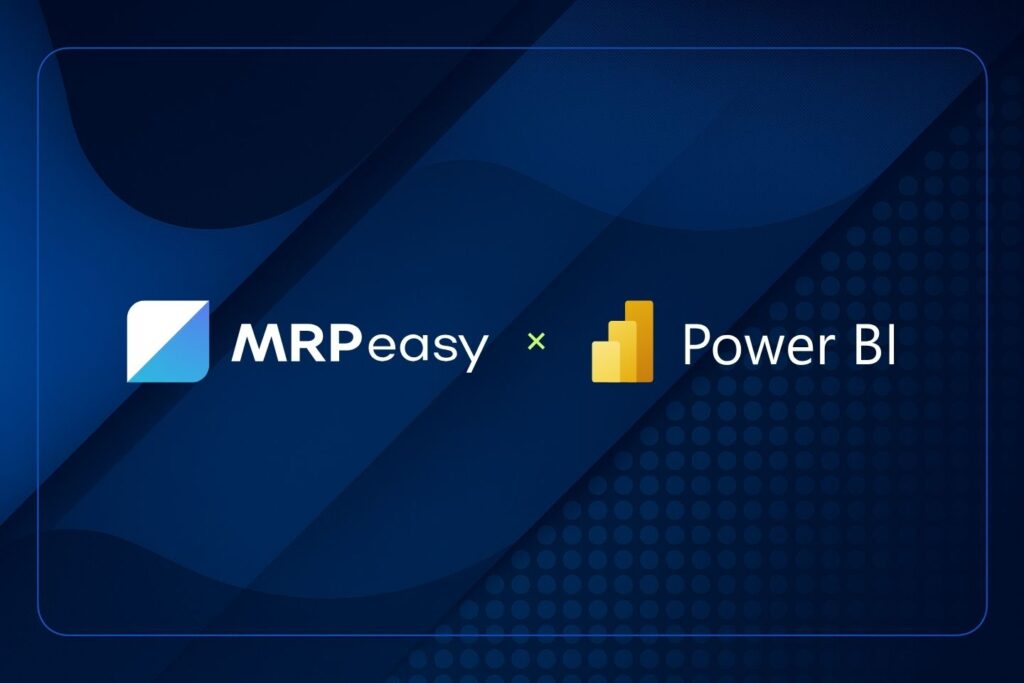Integrating with Microsoft Power BI for Improved Manufacturing Analytics
MRPeasy has announced a new native integration with Microsoft Power BI, a leading business intelligence and data visualization platform that enables manufacturers to use their operational data for continuous improvement.

What is Microsoft Power BI?
Microsoft Power BI Service is a business analytics tool that enables users to visualize data, share insights across their organization, and embed them in apps or websites. Developed by Microsoft as part of its Power Platform suite, Power BI empowers users to connect to an array of data sources and build interactive reports and dashboards with ease.
Within the manufacturing sector, Power BI offers solutions for optimizing production performance and reducing downtime, improving cost control, and increasing visibility into supply chain dynamics. With its robust capabilities, Power BI helps manufacturers turn complex data into clear, data-driven strategies.
Why do ERP systems often need additional analytics software?
ERP systems are comprehensive tools designed to integrate core business functions like finance, inventory, procurement, human resources, and manufacturing. While they provide great value in streamlining operations and managing transactional data, they often fall short in a few areas, which is why additional business analytics software is often needed. Here’s why:
1. Limited advanced analytics capabilities
ERP systems typically offer basic reporting and standard analytics functions. However, they are not designed for complex data analysis or sophisticated decision-making insights. Analytical tools like Business Intelligence (BI) software or Data Warehouses can provide deeper insights by handling large datasets, running advanced analytics, and presenting them in interactive, visual ways (dashboards, reports, etc.).
2. Data integration and data quality
ERPs manage data within a specific scope (e.g., financials, inventory) and may not integrate well with external data sources or systems. Advanced analytical software is often designed to pull data from multiple systems (CRM, external databases, third-party apps, etc.) and clean it, allowing for more comprehensive and accurate insights.
3. Customization and flexibility
ERP systems are generally built with a one-size-fits-all approach to cater to a broad range of industries. However, business needs vary, and businesses may require tailored analytics for specific functions (e.g., sales forecasting, customer behavior analysis). Dedicated analytical tools allow users to customize the metrics, reports, and dashboards to match specific business requirements.
4. Predictive analytics and forecasting
ERPs focus mainly on past and current operational data. Business analytical software, on the other hand, can support predictive analytics and machine learning models to forecast future trends, like sales growth, market demands, or financial risks, helping companies plan better and make proactive decisions.
5. Data visualization
Advanced analytical tools offer sophisticated data visualization features (graphs, charts, heatmaps, etc.), making it easier to interpret complex data. ERP systems typically provide more traditional reporting tools that may not be as user-friendly or visually impactful.
7. User-friendliness for non-technical users
Business analytical tools are often designed with non-technical users in mind, offering drag-and-drop interfaces or intuitive dashboards, whereas ERP systems are more geared toward operational management and often require technical know-how to extract meaningful insights.
8. Deeper insights into KPIs and metrics
While ERPs track operational data, they may not provide comprehensive insights into the most important KPIs to strategic decision-makers. Analytical software can help track custom KPIs, monitor performance across different departments, and identify areas for improvement.
9. Long-term strategic planning
ERPs are essential for day-to-day operations, but additional analytics tools are more suited for strategic long-term planning and high-level decision-making. They can help businesses analyze industry trends, competition, and market opportunities, something ERPs generally don’t provide.
In summary, while ERP systems are great for managing day-to-day operations and transactional data, they may lack the depth required for complex analysis, forecasting, and strategic decision-making. This is why many businesses integrate specialized business analytics software to fill in these gaps.
Benefits of integrating MS Power BI with MRPeasy
The integration of Power BI with MRPeasy opens a new level of data analysis for small and mid-sized manufacturers. By combining MRPeasy’s comprehensive manufacturing functionality with Power BI’s advanced reporting tools, users gain:
1. Real-time production performance monitoring
Power BI dashboards can be configured to monitor manufacturing KPIs such as planned vs. actual production duration and time efficiency rate of manufacturing orders. This real-time visibility helps production managers identify bottlenecks and reduce unplanned downtime.
2. Improved inventory and procurement management
By pulling inventory levels and stock movement data from MRPeasy into Power BI, users can build visualizations that track material consumption, inventory turnover rates, and inventory value. This enables you to prevent shortages, avoid overstocking, and make more informed procurement decisions based on trends and seasonality. Integrating purchase order data and incoming goods quality inspection data enables companies to evaluate supplier performance, quality, and costs.
3. Useful financial insights
Power BI makes it easier to track revenues and profitability by combining data from various MRPeasy modules. Finance teams can visualize revenues and profits, compare actual vs. planned costs, and detect anomalies—allowing you to refine your pricing strategies and find cost-reduction opportunities.
4. Better sales and customer analytics
Sales data from MRPeasy can be transformed into interactive dashboards that track customer order statuses and history, revenues and profits per order or product, invoice history, and much more. This allows managers to ensure healthy cash flow, identify high-value customers and underselling products, and discover bottlenecks in the order fulfillment process.
5. Custom dashboards for easy performance tracking
The integration supports building consolidated dashboards that bring together data from production, inventory, sales, and finance. This bird’s-eye view enables leadership teams to perform scenario planning, monitor company-wide KPIs, and align teams on strategic goals with a single source of truth.
6. Faster, more informed decision-making
With all critical data visualized in one place, decision-makers no longer need to rely on spreadsheets or wait for end-of-month reports. Instead, they gain continuous insight into their operations, empowering them to act quickly when issues arise or opportunities emerge.
How the integration works
The integration between MRPeasy and Microsoft Power BI makes it easy to turn your MRPeasy data into interactive reports and dashboards. Once set up, MRPeasy sends data from the past 12 months directly into Power BI. The structure of the data and the relationships between tables are already preconfigured, so you can start using it right away—no manual setup is needed.
Be aware that each upload replaces the previous dataset with the same name. If you want to keep older versions, rename the existing dataset in Power BI before uploading again.
After uploading, you can start building reports in Power BI Service. Just open the dataset, click “Explore this data” or “Create a blank report,” and begin adding visuals like charts, tables, and KPIs. To create a dashboard, open your report, click the pin icon, and choose to add it to a new or existing dashboard.
For a detailed guide, visit the MRPeasy Power BI Integration Guide



